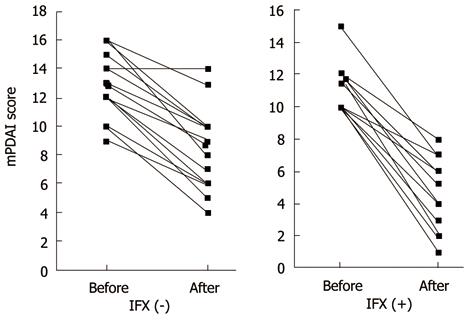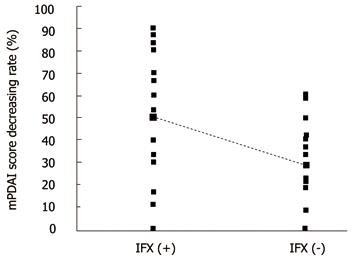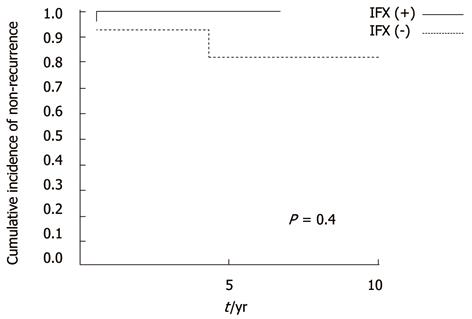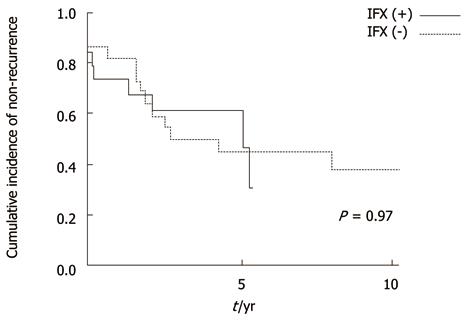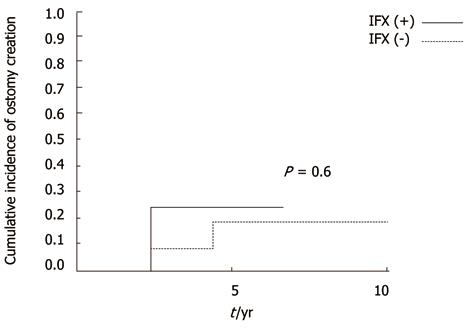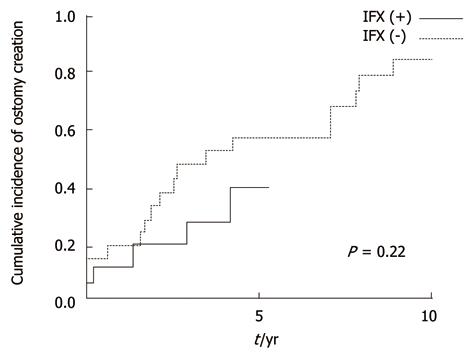Copyright
©2011 Baishideng Publishing Group Co.
World J Gastroenterol. Mar 7, 2011; 17(9): 1174-1179
Published online Mar 7, 2011. doi: 10.3748/wjg.v17.i9.1174
Published online Mar 7, 2011. doi: 10.3748/wjg.v17.i9.1174
Figure 1 Individual modified perianal Crohn’s disease activity index scores in patients before surgery and 12-15 wk after surgery with or without infliximab.
The modified perianal Crohn's disease activity index (mPDAI) scores improved significantly with surgery regardless of infliximab (IFX) treatment: from 13.5 (9-16) before surgery to 9.5 (4-14) after surgery without IFX; from 11 (8-15) before surgery to 6 (1-10) with IFX (P < 0.01).
Figure 2 Decreasing rate of the modified perianal Crohn’s disease activity index score after surgery in regards to infliximab.
The squares represent the median value and the circles represent range plots. The rate of reduction in modified perianal Crohn's disease activity index (mPDAI) score from baseline was significantly greater in patients with infliximab (IFX) -50.0% (0%-90%) - than in those without IFX -28.6% (0%-60%); (P = 0.003).
Figure 3 Cumulative incidence of maintaining non-recurrent status in patients without anorectal stricture.
The cumulative incidence of fistula recurrence was 0%/5 years with infliximab (IFX) (n = 7) and 17.5%/10 years without IFX (n = 15), respectively.
Figure 4 Cumulative incidence of maintaining non-recurrent status in patients with anorectal stricture.
The cumulative incidence of fistula recurrence was 53.9%/5 years with infliximab (IFX) (n = 19) and 55.0%/5 years and 62.5%/10 years without IFX (n = 21), respectively.
Figure 5 Cumulative incidence of ostomy creation in patients without anorectal stricture.
The cumulative incidence of ostomy creation was 25.0%/5 years with infliximab (IFX) (n = 7) and 18.5%/5 years without IFX (n = 15), respectively.
Figure 6 Cumulative incidence of ostomy creation in patients with anorectal stricture.
The cumulative incidence of ostomy creation was 38.9%/5 years with infliximab (IFX) (n = 19) and 56.5%/5 years and 83.7%/10 years without IFX (n = 21), respectively.
- Citation: Uchino M, Ikeuchi H, Bando T, Matsuoka H, Takesue Y, Takahashi Y, Matsumoto T, Tomita N. Long-term efficacy of infliximab maintenance therapy for perianal Crohn’s disease. World J Gastroenterol 2011; 17(9): 1174-1179
- URL: https://www.wjgnet.com/1007-9327/full/v17/i9/1174.htm
- DOI: https://dx.doi.org/10.3748/wjg.v17.i9.1174









